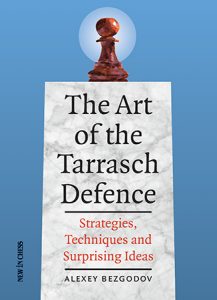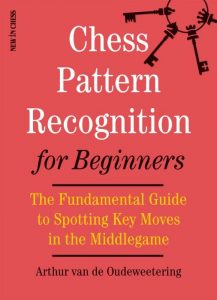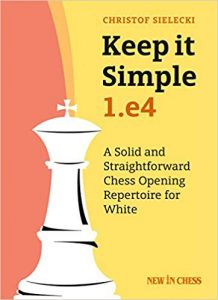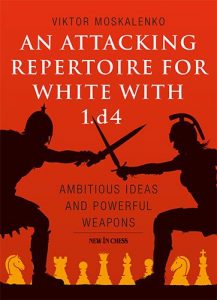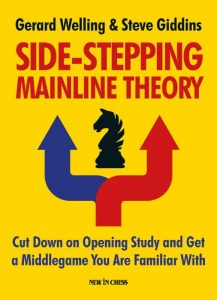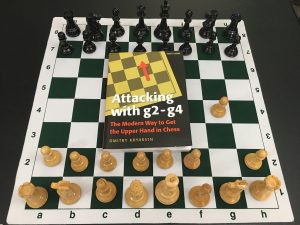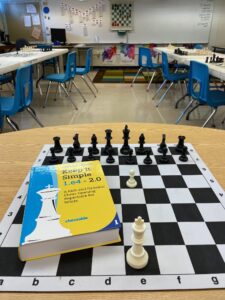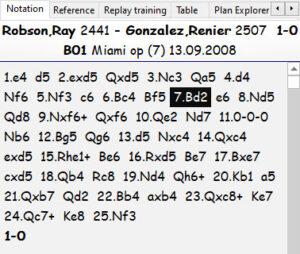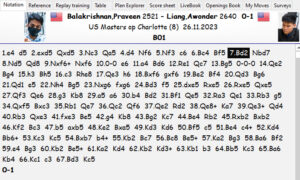Spring Break 2018 New in Chess Reviews
This Spring Break 2018 we have a great selection of chess books to read, learn and enjoy. The first book is The Art of the Tarrasch Defense by Alexey Bezgodov, followed by The Complete French, Advance by Evgeny and Vladimir Sveshnikov and the last book is dismantling the Sicilian by Jesus De La Villa and Max Illingworth. I asked New in Chess (NIC) for the three books in this review because I was familiar either with the author’s work or the subject topic
The Art of the Tarrasch Defense
The Art of the Tarrach Defense by Alexey Bezgodov, a much needed book on this classic opening. The author really conveys the essence of this opening using a format that is both, instructive to players and coaches alike. Previous efforts on the Tarrash by Collins and Aagaard and Ntislis (both books reviewed by me) peak my interest in this defense as well as a comment by Jonathan Hilton on his book Wojo Weapons Vol 1 (Hilton states that amateurs do poorly on the black side of the Tarrasch due to their lack of knowledge in the early middle game). I jumped at the opportunity to review this book and determine its value to the improving amateur hungry to learn how to play the Tarrash Defense after 1.d4
Bezgodov command of the subject allows him to present the material in the more practical/ tournament player fashion at the same time that the historical contribution of the world best chess players is preserved. The first part of the book helps the reader to use the Tarrash Defense against 1. d4 with confidence. In other words, after mastering the first fifty two pages of this book the reader can “hit the ground running” and start using this opening in tournament games. I will recommend to the reader to do the ninety six puzzles at the end of the book before playing rated chess games. The authors wrote the book in a way that the role of past leading players in the Tarrasch Defense such as Kasparoy and Spassky among others is both, acknowledge and understood.
The Art of the Tarrasch Defense reminds me of my training with V. Akobian on this opening because both, Bezgodov and Akobian can translate their extensive experience on the Tarrash in easy to follow and ready to use lessons. Great Read!
The Complete French Advance
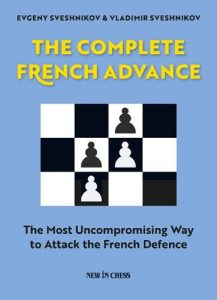
Writing chess books are getting more and more difficult because authors needed to add value to the already large amount of existing books on opening theory and create an engaging piece of work. The Complete French Advance Evgeny and Vladimir Sveshnikov is the right tool to understand how to play against the French as white and the audience can enjoy a book with a good blend of historical background and computer checked analysis.
Chess players that open with 1. e4 will eventually face the challenge of finding a suitable method to tackle the French Defense. This choice is not easy, but in the Complete French, Advance the authors lay out in easy terms the value of the main choices available to White at move three against the French, named 3. Nd2, 3. Nc3 and 3.e5. The authors explain why 3. e5 is the best practical choice despite 3. Nc3 being the more principle choice. Importantly, the first chapter is a mix of key historic games in the French Advance and a fine framework of key ideas and plans. In other words, the readers become familiar with both, the historical evolution of the advance variation against the French and the main ideas to understand the variation. To this effect the first model games are grouped by themes instead of variations.
The main values of this book are that E. Sveshnikov is a rare breed of trainer and practical player. For example, E. Sveshnikov works regularly with top raising starts as a trainer and he is also a long time practitioner of the French advance, who keep playing “his variation” against experts on the French defense such as Gurevich (see model game 118) with good results. Second, The Complete French Advance is a book that distills the best of both authors E. Sveshnikov as expert in the field and Vladimir Sveshnikov expertise in computer analysis and literature survey. This book is aimed at players below master candidate level and is recommended without reservations.
Dismantling the Sicilian: A Complete Modern Repertoire for White

Dismantling the Sicilian: A Complete Modern Repertoire for White by Jesus De La Villa and Max Illingworth is a revised, updated and new version of Jesus Dela Villa classic book repertoire based on the English Attack (2009). The main premise in this book is that White will fight for the advantage and will hit hard black if the second player relies on natural developing moves. The authors tackle a very difficult task building a repertoire against the Sicilian Defense, but they know their craft and make great efforts to make the material accessible to amateurs that want to take the challenge and meet the Sicilian in the main lines.
The Sicilan long with 1…e5 are the most direct approaches to stop white to achieve a e4-d4 pawn duo in the center. Over the years the Sicilian becomes more popular that 1… e5 at both, professional and amateur levels, mainly because the unbalance pawn structure and the fact that white has to take risks if he wants to win. To fight for the advantage in the open Sicilian is not an easy goal, but can White can be rewarded with victories against superior opposition at amateur and professional level alike if he spend the time on this repertoire book.
For example, The Grivas Variation 1. e4 c5 2. Nf3 Nc6 3. d4 cxd4 4. Nxd4 Qb6 5. Nb3 Nf6 6. Nc3 e6 is an interesting variation and the authors explain the idea behind it (to achieve a Scheveningen set after the white dominant knight on d4 is forced to move to b3). I compared the Analysis of E. Grivas (The Complete Guide to the Grivas Sicilian, 2005) with the author’s analysis and founded that despite Grivas sound analysis the authors were able to find a dent in black’s armor. De la Villa and Illingworth suggest three different ways to fight for the advantage, named 12 Qd2, h4 and Qe2. The game Bogner (2599) – Naiditsch (2702) is a good example of the practical punch this repertoire book has a high level. Importantly, in the Grivas Sicilian one of the main claims for black was that after 7. a3 White cannot castle long, but in Dismantling the Sicilian: A Complete Modern Repertoire for White the authors (and the game above) show you that black needs to reevaluate his options because after all 0-0-0 is possible. This book injects new life to the open Sicilian as white and the ideas and methods of play are at the reach of amateur players. Recommended!
Winter Break 2019 Reviews
In my opinion, chess amateurs are equally eager than chess professionals to improve, but their efforts get diluted by the time constraints of their life (family and work commitments) and working on the wrong aspects of their chess. Many amateur chess players actively look for ways to improve their chess skills and allocate a good portion of their free time to study chess, but unfortunately the results fell short of the mark. Why? Chess improvement involves the interplay of many factors such as
1. Knowledge of typical positions
2. Calculation of variations
3. Evaluation of the variations you calculated
4. How you apply your knowledge on the heat of the battle
The following paragraphs are suggestions of how an amateur chess player can get the right information for his current level, train more efficiently and close the gap between his current level and level he/she wants to be.
To play well against your opponent, you need to combine a series of chess skills such as time management, tactical alertness and technical skill, and more importantly to use an efficient thinking process over the board. Now that the problems are outlined what can we do to solve them? I can make a suggestion of different books and resources that in my opinion will help a diligent chess player to have a chance to improve at chess.
Knowledge of typical positions
As chess players we need to choose among the several moves available to us before and after every move. Fortunately for us most chess games contain several patterns that guide our decision making process. Some patterns are tactical and other are of a strategic nature. As a chess players advance in chess there is the need to learn and refine his/her ability to recognize and evaluate strategic and tactical patterns. Significantly, this knowledge of typical positions growth along with the demands of his immediate goal (class he wants to belong). For instance, the position a 1200 rated player(Class D) are different to the positions an 1800 rated players needs to know to move to expert.
A class D player can increase his stock of typical position by studying the last book by IM Arthur van de Oudeweetering,
Chess Pattern Recognition for Beginners.
The author explains a set of strategic patterns that every chess player rated over 1200 USCF needs to know. The word beginner in the title of the book does not mean the content of the book is basic or simplistic. The author defines his work as the first step every chess player must take his/her journey to progress to higher levels of chess understanding and practical play.
Vladimir Chuchelov pointed out in the foreword of Chess Pattern Recognition for Beginners that advance and top players evaluate chess positions to a higher degree of complexity than less experience players. In other words, the material in Chess Pattern Recognition for Beginners is the material a beginner learns as part of his/her initial chess education and will serve as scaffold to acquire more sophisticated positional knowledge in the future.
The main values that Chess Pattern Recognition for Beginners has to offer to the readers are the quality of the examples, the order the material is presented, the use of the right amount of words instead of long variations and the puzzles at the beginning of some chapters and at the end of each part. Having Puzzles at the beginning of each chapter helps the audience to get more involve with the material to be discussed in the chapter.
Better Thinking Better Chess
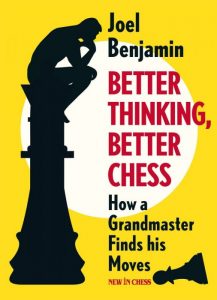
Better Thinking Better chess by GM and chess coach Joel Benjamin is a chess book about how to improve our chess think process over the board to boost our practical results. The author as well as New in Chess editor Rene Olthof did an outstanding job in this book incorporating the main premise of the book around a core of key chess topics in only two hundred and twenty three pages. GM Benjamin explains how we can make our thinking process more efficient when we apply our brains to solve recurrent problems for most amateurs and professionals alike named, how to learn openings, according to your skill level, the importance of planning in chess, how to improve our tactics by “aiming high”, how to calculate more efficiently, the work on tactics, the interplay between material and the initiative, winning a won game, swindling and translating your endgame knowledge into better practical results.
The author offers to players and chess coaches his experience and the how to improve your thinking processes at every stage of a chess game. For example, GM, Benjamin explains why your opening preparation should aim to get a middle game that allow you to develop a plan. Next, convert your endgame knowledge into a good decision making beacon and to play chess more efficiently. The chapter on tactics and calculation provides the reader with a method to approach tactics in your chess games. I found valuable how the author incorporates technical aspects of chess with the unique elements of every chess game. For instance. A common scenario in which a high rated player may over press an equal position because he/she feels compelled to win. In this situation the author recommends that the lower rated player must actively search for traps to take advantage of his opponent’s psychological error (lack of objectivity)
Chapter five deals with problems with calculation and cognition. This chapter was an eye opener to me, especially the explanations about why reaching a rating number in chess does not automatically translate into permanent, solid chess skills and the differences between stronger and lesser chess player when they calculate. Both concepts will be valuable to improving chess players that believe that reaching a rating in chess means durable skills and expect to make it to the next level without the necessary skills to beat the competition. The author make a good job pointing the audience to the right resources and methods to acquire durable chess skills, particularly how to become better calculators.
The last three chapters of Better Thinking Better Chess cover the relationship between material and the initiative, winning a won game and swindles. This part of the book gives the reader practical tips on how to identify and overcome the mental obstacles that prevents a player to sacrifice material when the outcome of the sacrifice is unclear. A novel idea to me was to sacrifice material not to win but to avoid landing in a strategically loss position. First and foremost, these three chapter highlights the importance of working hard at the board even when the position seems one or “easy” to play. Hard work on the board can also bring good results when defending worst or lost positions because the player defending will search for cunning traps or swindles to turn the tables on his opponent.
Finally, since GM Benjamin is also a coach the audience will find that the author completes a “review” of the material with a list of recommendations to improve your thinking process and practical results as well as a complete list of all the games used in the book classified by topic. The detailed classification of the games helps the reader to generate printouts or other review/ teaching materials using his own chess database.
Better Thinking Better Chess is one of the most complete and reader friendly guides to improve our chess thinking process. The book covers the subject of a more efficient thinking process from both, the theoretical and practical angles. This book is a must for every chess player and chess coach
Keep it Simple 1.e4
Keep it Simple 1.e4 is the new repertoire book for White by German International Master Christof Sielecki, that follows on our central theme this Winter Break 2019 of improving at chess by saving time to work on key areas of chess improvement (see the introduction of this winter break review series above)
The central premise behind Keep it Simple 1.e4 is to provide White with a solid, easy to learn and recall repertoire that sets practical problems over the board to black. The author recommends lines that are not forcing and aims to obtain a comfortable edge against black better alternatives. In contrast, Sielecki proposes sharp, forcing play to punish black weak or unsound opening play. Sielecki’s practical approach to 1.e4 gives club players a high return investment for the time they use learning the repertoire.
I find Keep it Simple 1.e4 a time saving repertoire for club players for three reasons. First, you do not have to spend tons of time learning, forcing lines to out prepare your opponent and reach a +/= evaluation. Second, the sample games in each chapter give the reader enough material to understand what he is doing in the early middle game and play the middle game with confidence. Finally, the repertoire is modular. In other words you can play the proposed lines against the Sicilian defense and keep your current lines against 1… e5 if you are happy with your results against the open games. Also, as you improve as a chess player you can retain some of your favorite lines of recommended by Sielecki and bring more complicated lines as you playing strength and level of the opposition increases.
I believe the players that use Keep it Simple 1.e4 will improve at chess because a good chunk of their chess time will be used to learn and understand critical aspects of chess such as endgames, strategy and of course tournament play! Keep it Simple 1.e4 indirectly, helps the club player to work on the right priorities and to use his time dedicate to more efficiently.
A pleasant surprise to the readers of Keep it Simple 1.e4 is that the content is also available on the Chessable platform to practice the lines and reinforce your learning process. I consider Keep it Simple 1.e4 a valuable tool for improving and practical chess players because the author does all the heavy lifting for the reader so he/she can devote his/her study time to master the game. Keep it Simple 1.e4 is a well-crafted, modular chess repertoire at a very affordable price. Recommended!
An Attacking Repertoire for White with 1. d4 by Viktor Moskalenko
Every chess player needs an opening repertoire to steer the game to the type of middle game he/she likes or in Bent Larsen’s words “A way to discuss chess”. I like Larsen’s analogy between openings and discussion because in a discussion the person with the better arguments and the more efficient way to get his point across communicates better, smoothly and convincingly. In the same line of thought, in chess the player with a coherent opening repertoire tailor to his level of chess understanding has greater chances to succeed than a player with a collection of unrelated opening.
If you are a d4 player that likes active positions out of the opening supported by a dynamic pawn center, then An Attacking Repertoire for White with 1. by Viktor Moskalenko is a good option to consider. The repertoire is built around the author’s own experience and contributions to publications like the New in Chess Yearbook series. In other words, the recommendations are theoretically sound and you can find a good amount of master games in the databases. If you are curious about how opening theory evolves you can follow Mosalenko discovery of 4. Qc2 versus the Benko Gambit in a series of articles in several chess sources. In contrast, if you are a practical player, then read Mosalenko’s recommendations after 4.Qc2 against the Benko in An Attacking Repertoire for White with 1. d4 and get years of grand master knowledge for the cost of a single book.
Mosalenko uses in An Attacking Repertoire for White with 1. d4 a game annotation format that combines complete master games with supplemental game fragments to illustrate alternative moves. Then the author adds the possible move transposition, plans in a particular position, evaluation of the resulting positions (informatory style or words), markers to point out how a dubious move can be punished (with the title weapon) and questions to the reader to help him to engage with the material and avoid passive learning.
The constant factor in all of Mosalenko recommendations is pressure from the go. However, the reader will find different pawn centers from the direct massive pawns attack versus the Kings Indian and Nimzo Indian to the stable central pawn duo e4-d4 against the Gruenfeld, going down to the isolated queen pawn versus the Queens Gambit Accepted to the symmetric pawn distribution in the Exchange Slav.
An Attacking Repertoire for White with 1. d4 by Viktor Moskalenko is a valuable resource for players of all levels, especially players in the 1800 -1900 USCF rating range that need a strong repertoire to move to the expert and masters ranks. The Mosalenko’s work will provide the strong club chess player with the tools to fight for the advantage with the White pieces at the same time that increases his knowledge of typical plans in different pawn centers. Mosalenko created a sound opening repertoire for d4 players and with room to be expanded by the diligent reader. Importantly, despite the massive amount of information in the book, Mosalenko make the content easy to read and enjoyable (no your everyday dry repertoire book)
The Hippopotamus Defence: A Deceptively Dangerous Universal Chess Opening System for Black
Chess is a fight and chess players can be grouped in two categories depending if they want to start the fight right out of the opening or delay the fight until the middle game. The first group of players follows chess theory and enjoy the study of the latest games in the openings they play. As a reward for their hard work these groups of players usually reach master level and manage to extract an advantage with White and to reach a theoretical sound position with Black. The second group of players likes to put the weight of the game in the middle game and prefer to play system openings that consistently give them the type of positions they like with the chance to outplay their less prepared peers.
If you belong to the second group of players and want to play your games with the Black pieces around a concept instead of variations The Hippopotamus Defence (Hippo for short) may be the right fit for you. The Hippo can be played at three different levels depending on the player skill level. The first level are players with not that much experience that want a way to deploy their pieces in good squares and do not lose out of the opening. The second group of players used to play a major opening such as the French, Kings Indian or Dutch, but want an opening that allows them to tame the aggression of their opponents. This group of players wants to outplay their opponents by transposing the game to a main stream pawn structure in which the White pieces are miss placed. Finally, we have the level three players that want to become a chess master and have the skill to neutralize master level opposition from a cramp position and feels comfortable maneuvering his pieces in three ranks.
The Hippopotamus Defence: A Deceptively Dangerous Universal Chess Opening System for Black, Italian FM Alessio De Santis provides the framework to play a counter attacking system with the Black pieces against most of White main openings. The author clearly differentiates the way to handle the Black pieces, depending on White’s piece set up. In other words, from a basic or ideal set up Black adjust his responses to White’s opening strategy. What separates De Santis’s book from previous work on the Hippo are the inclusion of a detailed inclusion of pawn structures and the plans associated with them.
The more advance the level of play, the more flexible and dangerous the Hippo becomes, yet if you are on the lower ladder of chess the fact that you can play nine to ten moves without that much thinking is a great plus if you fear chess theory. In contrast, if you are an experience chess player you can turn the year of experience in other pawn structures in a formidable weapon to beat your opponents by transposing to good structures. After 2100 USCF playing the Hippo is a difficult endeavor master are better prepared to avoid unfavorable transpositions and are technically skilled to play long games nurturing a small plus.
According to my own experience with players I face over the board in Florida (USA) a chess player can grow from intermediate to strong club player with the Hippo if he feels comfortable with a slow pace in the opening as Black and has the patience to wait until the right moment to seize the initiative. The Hippopotamus Defence: A Deceptively Dangerous Universal Chess Opening System for Black, by FM Alessio De Santis will make the learning and understanding of the Hippo easier than learning this concept using just a computer database.
Caveats and observation
I recommend to beginners to start with the open games 1… e5 as response to 1. e4 before taking on the Hippo because the experience in open positions is a must to grow as a chess player and enjoy the chess heritage of the old masters. Finally, about the title. Defence is the preferred spelling in British English.
Sidestepping Main Line Theory
Most amateur games are decided by tactical mistakes in the middlegame or gross blunders in the endgame. However, most club players spend most of their time studying chess openings. A player can free study time to improve his middle and endgame play if the time devote to the opening is cut to a minimum. In other words, amateurs cannot play demanding openings as the professionals do. Yet amateurs should play the opening following, a consistent philosophy of play, knowing the move orders and transpositions as well as the middlegame plans and spawn structures associated with the opening. The latest book by Gerald Welling and Steve Giddins Side-stepping Main Line Theory is a good resource to help amateur players to play the opening effectively as suggested above.
Side-stepping Main Line Theory suggests the Old Indian and the Philidor structures as the more friendly options to the amateur player. The positions out of the Old Indian and can be equal or slightly worse (especially with the Black pieces). However, the better knowledge of move order, typical plans and piece maneuvers will give the reader chances to put a good fight. Players with a good feeling or preference for strategic play will get the most out of Sidestepping Main Line Theory.
The authors help the reader to master the Old Indian and Philidor structure by combining ninety two well annotated games with summary tables of the main variations. The annotations in every game explain why a particular move order is better than another, the aims of the opening (what you should do in the middle game), when a particular maneuver is effective against a particular set up. Gidding editorial work with New in Chess allow him to enrich every game with the key games in the variation at hand. For example, in game forty seven, Ostojic – Ree, Budapest 1977, contains the relevant strategic factors of the Philidor main line as well as a clear illustration on how tactics serve strategy.
In Side-stepping Main Line Theory the game selection also helps the reader to understand the complexity of a position without using pages and pages of analysis. For instance, game seventy three, Capablanca – Grommer, New York 1913 is followed by Carlsen – Caruana, Bilbao 2012. Out of similar opening moves the first game is a classic example of Black being outclassed. In contrast, the second game is a modern battle in which Black riddle White with a series of technical obstacles to save the game. Caruana simplified the position at move twenty and forced Carlsen to play forty six more moves to win a deceitful dull position.
In addition to the insightful annotations Sidestepping Main Line Theory has a quick reference table with the all the variations covered in the book. The tables are supplemented with the games and keynotes from the corresponding chapter in the book. Importantly, each line in the table has an evaluation at the end to inform the reader what to expect in the middlegame. My overall feeling about Sidestepping Main Line Theory is that the reader gets what the authors promised and the book is really a time saver resource for amateur chess players. Giddins and Welling put together a very instructive book in less than three hundred pages.
Side-stepping Main Line Theory combines good openings selection, relevant games to illustrate the move orders and middle game plans, rich annotations and a format that helps the reader to find a learn the material in the book.
Beyond Material

Chess is a game of vast complexity. Beginner chess players orientated in a maze of possibilities based on two concepts, material and checkmate. The interplay between material and checkmate provides the main directive to choose a move or a plan at lower levels of chess. In consequence, it is not a surprise that most of the chess training a beginner and intermediate player consist mostly of checkmate and winning material puzzles. A negative side effect of this way of training is that a player may take the nominal value of the pieces to heart and neglect sacrificing material if he cannot see the checkmate or an immediate material gain.
Croatian GM Davorin Kuljasevic’s new chess book, Beyond Material will take intermediate players to a new dimension of chess understanding and practical performance. Beyond Material is the most complete resource on the market explaining the value of the chess pieces and pawns in the context of space, time, psychology and the player’s style. The author helps the reader to recognize that the main roadblocks to chess improvement are of a psychological and technical nature. Both chess, improving barriers are rooted in the way a chess player assigns values to the chess pieces on the board. In Beyond Material the author discuss and explain all the psychological and technical parameters that affect the value of material in chess. Armed with this new knowledge the reader can reach new dimensions of chess skill.
In my opinion, the most relevant features of Beyond Material is the personal connection that the author establishes with the reader and the actionable advice to improve your chess. As you read Beyond Material it feels as if Kuljasevic’s was next to you as a coach. The examples in the book are not geared to impress you, but to help you to become a better chess player. The author states the problems, the possible causes behind and actionable advice to improve your results.
Advance players can also benefit from Beyond Material especially readers that enjoyed Cyrus Lakdawala’s Chess For Hawks book (New In Chess 2017) and thought of themselves as “doves”. Beyond Material contains the methods to help a “dove” to become a “hawk”. Beyond Material does a great service to players with a positional oriented o solid style. The author shows how to grow from the Steinitz’s positional way of play to a more dynamic/flexible approach to chess.
I recommend Beyond Material to players looking to understand material in chess as professionals do. As you can see in the picture my review copy is full of post it notes. Beyond Material is full of actionable advice!
.
Spring Break New in Chess Reviews 2020
Attacking with g2-g4 by GM Dimitry Kryakvin
Attacking with g2-g4 by GM Dimitry Kryakvin is an instructional chess book that follows the traditional Russian standards. Yet, Attacking with g2-g4 is a page-turner that reads as modern, modular instructional book. The author starts the book with the historical evolution of the move g2-g4 in the context of the games of Mihail Botvinnik and the work of Isaak Lipnitsky. Next, Kryakvin uses eighty four annotated chess games containing the trust g2-g4 to illustrate when this anti-positional looking moves packs a punch. The games are grouped by chess openings such as the Dutch, Queens Gambit, Nimzoindian, Slav, Kings Indian and the Gruenfeld. The theoretical backbone of Attacking with g2-g4 comes from the author’s chess erudition as a player, trainer and avid student of the game.
Chess amateurs find difficult to grasp unusual chess ideas such as g2-g4 because they go against orthodox principles. This lack of flexibility comes from an incomplete chess education beyond the fundamentals of opening principles. However, chess enthusiast cannot be totally blamed for these shortcomings because, until now the chess literature has a comprehensive and well structure book on the move g2-g4.
The book Attacking with g2-g4, brings and explains this unconventional advance of the g pawn to the amateur players (assuming that all professionals already know this information). The author starts the book with an historical review of the g2-g4 plan at the master level with the annotations of early, yet relevant games played by M. Botvinnik’s. Importantly, the author clearly traces Botvinnik interest in the unorthodox advance, g2-g4 to the work of Isaak Lipnitsky (author of the book Questions of Modern Chess Theory). Lipnitsky, explains why in some positions with static weaknesses on the queenside White has to rely on the bold g2-g4 to stay in the game. After this historical review of the origin of g2-g4 in master chess the author is ready to move to more concrete examples and the reader is equipped with the tools to understand what is coming in the next chapters. It is noteworthy to mention that the author maintains this coherent explanation of the evolution of ideas/ plans around g2-g4 during the whole book.
The next pages of Attacking with g2-g4 shows the viability of the plan g2-g4 across different openings and pawn structures. Kryakvin explains the move sequences, possible transposition and the correct evaluation of many positions (not just the critical positions) resulting from g2-g4. As a result of Kryakvin’s annotations, the reader becomes familiar with the positional and concrete nuances that makes g2-g4 a good choice in a given position. The author challenges the reader to solve several positions in each chapter embedded in the model games. I like to point out that the games are annotated in a very efficient way. In contrast, the solution to the exercises proposed by the author are annotated heavily and provide great material for chess trainers.
One of the best features of Attacking with g2-g4 is how the author enriches the technical discussions with relevant anecdotes embedded in each chapter. For example, the story about the author’s unfulfilled expectations to spring the novelty move sequence 1. Nf3 Nf6 2. c4 e6 3Nc3 Bb4 4. g4 at the Groningen World Chess Championship Qualifier in 1997. In Groningen, two players, beat Kryakvin to use the g2-g4 in the move sequence mentioned above, named Michal Krasenkow and Vadim Zviagintsev. The author, uses Krasenkow and Zviagintsev’s games to illustrate Black possible responses to 4. g4 (4… d5 and h6 respectively) at the same time that gives proper credit to practitioners of the g2-g4 pawn advance.
In summary, Attacking with g2-g4 by GM Dimitry Kryakvin target many chess circles. At practical levels, this book is a must read for 1. d4 players and a valuable resource for Black players unfamiliar with the g2-g4 thrust against their pet defense. Trainers looking to help their trainees to prepare (for and against g2-g4 plans), will find a truck load of training positions in systematic fashion. Overall the book flows very well and it is a pleasant and instructive read.
Book Review:
Keep it Simple 1.e4- 2.0 by IM Christof Sielecki
If you’re learning the game or want an open battle from the start, 1.e4 is the best option. A chess opening repertoire that is based on 1.e4 tends to oscillate between two opposite extremes. On one end, we have a narrow repertoire, mostly around a system such as the Kings Indian Attack. On the other end of the spectrum, we have a detailed repertoire that covers the main lines, including the Open Sicilian, and it is geared towards professional players. In the middle of the spectrum we have Keep it Simple 1.e4- 2.0 by IM Christof Sielecki. A coherent chess opening repertoire has been put together by the author, which offers aggressive lines while keeping a manageable workload for the amateur player. Keep it Simple 1.e4-2.0 is designed for chess players who are ambitious and want a dynamic repertoire that packs a punch while also being manageable.
Keep it Simple 1.e4-2.0 is based on the first version of this repertoire published by New in Chess in 2018. Both the author and the publisher have evolved over the past five years, and the new version of Sielecki’s repertoire is superior. Keep it Simple 1.e4-2.0 is a six hundred and thirty long hard cover book. The author used color diagrams and color code arrows to enhance the visual effect and provide additional information without using words. Readers’ learning is facilitated by the placement of diagrams in the appropriate spots. For example, to demonstrate the progression of a position, the author can position several diagrams at the same level on the page creating and a “before and after effect”. Besides, this feature of the book helps the reader to calculate in their head and use the diagrams as stepping stones. It’s important to note that the variation lengths are easily digestible by the average amateur and connected with a straightforward explanation of the resulting positions. The mainline is written in a bold font, but the variations are not. This contrasting effect in the text helps the reader navigate the text and stay on track.
The content in Keep it Simple 1.e4-2.0 has a number of significant differences from the previous version. Sielecki’s recommendations aim to increase the complexity of middlegames. For example, The Four Knights was replaced by the Spanish or Ruy Lopez. The French Exchange was replaced by the Tarrasch variation. The Exchange Variation was used to replace the Two Knights against the Caro Kann, and the Austrian Attack took the place of the 4.Be3 line. However, the choices against the Sicilian remain the same: Rossolimo and Moscow variations.
Sielecki’s choice of Ruy Lopez to replace the Four Knights came as a pleasant surprise to me. The Spanish is not commonly considered by authors as the foundation of a 1.e4 opening repertoire for amateur players. The main reasons to turn down the Spanish as a response to 1.e4 e5 2.Nf3 Nc6 are in my opinion threefold. The author must begin by digesting a substantial amount of theory that demands hard work and expertise. Second, the authors need to make their recommendations user-friendly. In other words, the author needs extensive experience working with the target population and understanding their needs and skills. To conclude, we must overcome the misconception that the Ruy Lopez is not suitable for non-chess professionals.
The second significant change in Keep it Simple 1.e4-2.0 is the response to the Petroff. In the previous edition, after the move sequence, 1.e4 e5 2.Nf3 Nf6 white can force Black to stay “in repertoire” with 3.Nc3 with a transposition to Four Knights waters. However, in the current repertoire there is no easy way to force a transposition to the Ruy Lopez after black uncorks the Petroff. As a consequence, the author recommends playing 3.Nxe5. Taking on Petroff as White leads to different types of middle games than the Four Knights. Users of the first edition of the book can benefit from this guide to advancing to more mainstream openings.
It became clear to me that the changes were made for practical reasons instead of following the current opening trends. The author did not need to change the recommendation against a specific opening if it was still valid, but if there was a need to add clarification, he updated it. In the Scandinavian Qa5 variation, Sielecki maintains 7.Ne5 but adds an explanation on 10…Be4, which necessitates White’s accurate play. It is important to mention than 7.Ne5 is a better choice for the amateur players than 7.Bd2. Even when you can find spectacular games in the Bd2 line as Robson (2441) versus Gonzales (2507), Miami Open 2008.
Recently, black is doing better.
To end this review, it is worth mentioning that the author succeeds in explaining to the reader what to do after the opening is over. To put it differently, the reader receives a precise description of the early middlegame and middlegame plans. This is not as easy as it seems. Even though computer assistance is used, the author must create a repertoire that ends rationally, otherwise amateur players won’t be able to navigate the middlegames.

